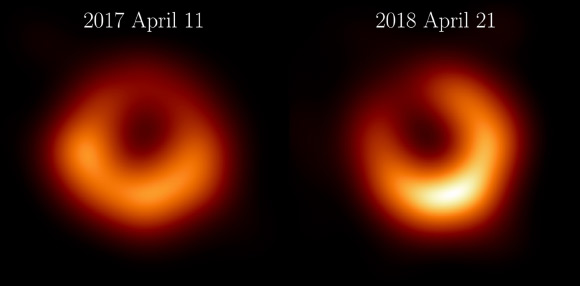In April 2019, the Event Horizon Telescope (EHT) Collaboration reported the first-ever event-horizon-scale images of a black hole, resolving the central black hole — known as M87* — in the giant elliptical galaxy Messier 87 (M 87). In a new paper, astronomers present new images of M87* from data collected by the Atacama Large Millimeter/submillimeter Array (ALMA), the Greenland Telescope and several other instruments within the EHT. These new images show the shadow of M87* as predicted by general relativity. Excitingly, the brightness peak of the ring has shifted by about 30º compared to the first images, which is consistent with theoretical understanding of variability from turbulent material around black holes.
The Event Horizon Telescope Collaboration released new images of M87* from observations taken in April 2018, one year after the first observations in April 2017. The new observations reveal a familiar, bright ring of emission, the same size as as first observed. The brightest part of the ring has shifted by about 30º, to a 5 o’clock position, relative to the 2017 image. Image credit: EHT Collaboration.
“A fundamental requirement of science is to be able to reproduce results,” said Dr. Keiichi Asada, an astronomer at Academia Sinica Institute for Astronomy and Astrophysics.
“Confirmation of the ring in a completely new data set is a huge milestone for our collaboration and a strong indication that we are looking at a black hole shadow and the material orbiting around it.”
The image of M87* taken in 2018 is remarkably similar to what the astronomers saw in 2017.
They see a bright ring of the same size, with a dark central region and one side of the ring brighter than the other.
The mass and distance of M87* will not appreciably increase throughout a human lifetime, so general relativity predicts that the ring diameter should stay the same from year to year.
The stability of the measured diameter in the images from 2017 to 2018 robustly supports the conclusion that M87* is well described by general relativity.
“One of the remarkable properties of a black hole is that its radius is strongly dependent on only one quantity: its mass,” said Dr. Nitika Yadlapalli Yurk, a postdoctoral researcher at NASA’s Jet Propulsion Laboratory.
“Since M87* is not accreting material — which would increase its mass — at a rapid rate, general relativity tells us that its radius will remain fairly unchanged over human history. It’s pretty exciting to see that our data confirm this prediction.”
While the size of the black hole shadow did not change between 2017 and 2018, the location of the brightest region around the ring did change significantly.
The bright region rotated about 30º counterclockwise to settle in the bottom right part of the ring at about the 5 o’clock position.
Historical observations of M87* with a less sensitive array and fewer telescopes also indicated that the shadow structure changes yearly but with less precision.
While the 2018 EHT array still cannot observe the jet emerging from M87*, the black hole spin axis predicted from the location of the brightest region around the ring is more consistent with the jet axis seen at other wavelengths.
“The biggest change, that the brightness peak shifted around the ring, is actually something we predicted when we published the first results in 2019,” said Dr. Britt Jeter, a postdoctoral researcher at Academia Sinica Institute for Astronomy and Astrophysics.
“While general relativity says the ring size should stay pretty fixed, the emission from the turbulent, messy accretion disk around the black hole will cause the brightest part of the ring to wobble around a common center.”
“The amount of wobble we see over time is something we can use to test our theories for the magnetic field and plasma environment around the black hole.”
The new results appear in the journal Astronomy & Astrophysics.
_____
The Event Horizon Telescope Collaboration. 2024. The persistent shadow of the supermassive black hole of M 87. I. Observations, calibration, imaging, and analysis. A&A 681, A79; doi: 10.1051/0004-6361/202347932


